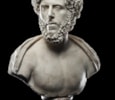Portrait Bust, possibly Lucius Verus
Portrait Bust, possibly Lucius Verus
Roman
C. 161-169 A.D.
Marble
H:73cm W:50cm
£185,000
This impressive bust is depicted with the head turned slightly to the right and gaze lifted. His eyes are articulated, with the pupils indicated with a drill, giving the face a striking realism. The shoulders are draped with a cloak. Straight brows sit beneath a mass of thickly curling hair, which continues to a full beard. It is worked with great skill, evident in the heavy drill work articulating and highlighting the voluminous curls, and the highly polished surfaces, giving the appearance of soft skin. The contrast between these textures gives a chiaroscuro affect which is one of the main traits of the best Antonine busts.
Roman marble portraits reached their apotheosis of craftsmanship and technique under the Antonine emperors, as is evidenced in this masterful bust. The evolution of the style may be traced back to the emperor Hadrian, who was the first emperor to wear a full beard. The articulation of pupils and iris appears on busts of his lover Antinous, a novelty which continued in later Antonine portraits, such as this one. The features of this bust point to a possible identification of Emperor Lucius Verus, who had only one portrait type during his relatively short reign, identified by Max Wegner and appropriately named the ’Main Type’.
Emperor from 161 to 169, he ruled alongside Marcus Aurelius. Tall, blonde, and good-looking, Verus continued the Antonine tradition of a full beard, although he grew his to the length and breadth of a 'barbarian'. He is said to have taken great pride in his hair and beard, and at times even to have sprinkled gold dust on it to further enhance its golden colour. He was an accomplished public speaker, a poet and enjoyed the company of scholars. He was also an ardent fan of chariot racing, publicly backing the 'Greens', the horse racing faction supported by the plebians of Rome, as well as showing an interest in physical activities such as hunting, wrestling, athletics, and gladiatorial combat. Verus fell ill towards the end of 168 while returning from an expedition to the Danube frontier, dying a few days into 169. Marcus Aurelius buried him alongside their adoptive father Antoninus Pius in the Mausoleum of Hadrian, Rome.
Whilst this bust most closely resembles Lucius Verus of all the Antonine emperors, it could be said to be of late Antonine style, possibly a member of the ruling classes paying homage to the emperor by commissioning a bust in the Imperial style.
Dessins, Tableaux Anciens et Modernes, Céramiques, Archéologie, Objets d’Art et d’Ameublement, Tapisseries, Tapis, Binoche et Giquello, Paris, 9 February 2021, Lot 109.
David Aaron Ltd, 2023, No.12.
Previously in a European Private Collection, 19th or early-20th century (based on restoration techniques).
Private Collection of Dr Pierre Calvelli (1921-2015), Aix-les-Bains, France, from at least 1982 (accompanied by customs letter dated 4th June 1982, Switzerland to France), most likely acquired on the Geneva art market.
Thence by descent to his daughters Anne-Claude and Emmanuelle in 2015 (accompanied by French cultural passport 226780).
Sold at: Dessins, Tableaux Anciens et Modernes, Céramiques, Archéologie, Objets d’Art et d’Ameublement, Tapisseries, Tapis, Binoche et Giquello, Paris, 9 February 2021, Lot 109 (1982 document discovered post-sale).
ALR: S00212712, with IADAA Certificate, this item has been checked against the Interpol database.










 Enquire
Enquire




